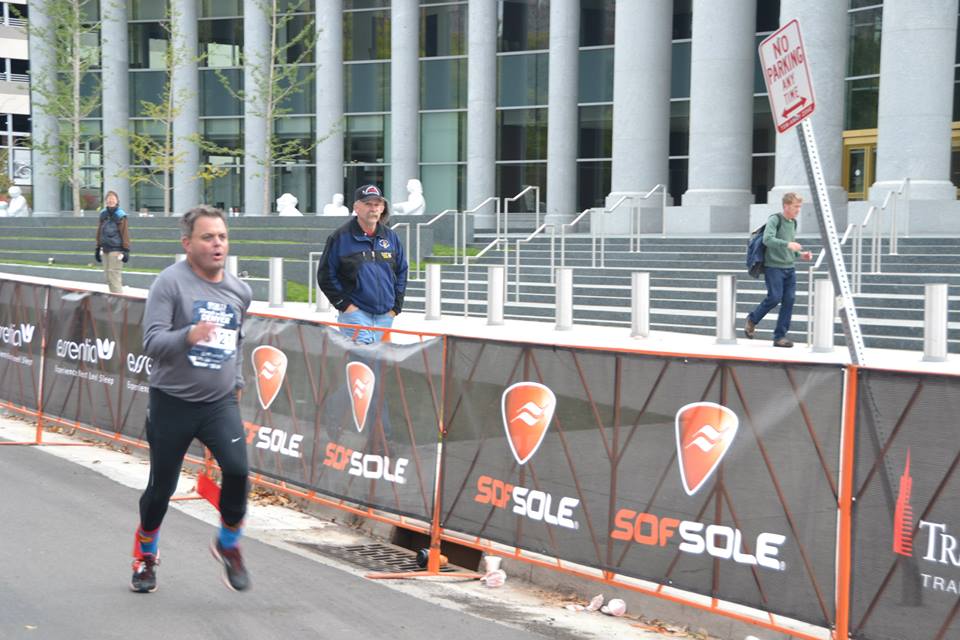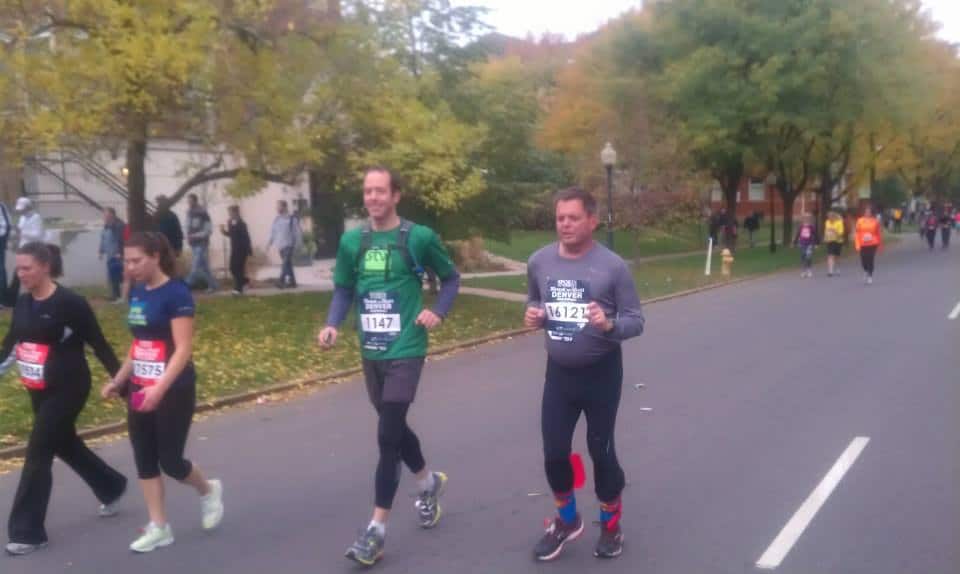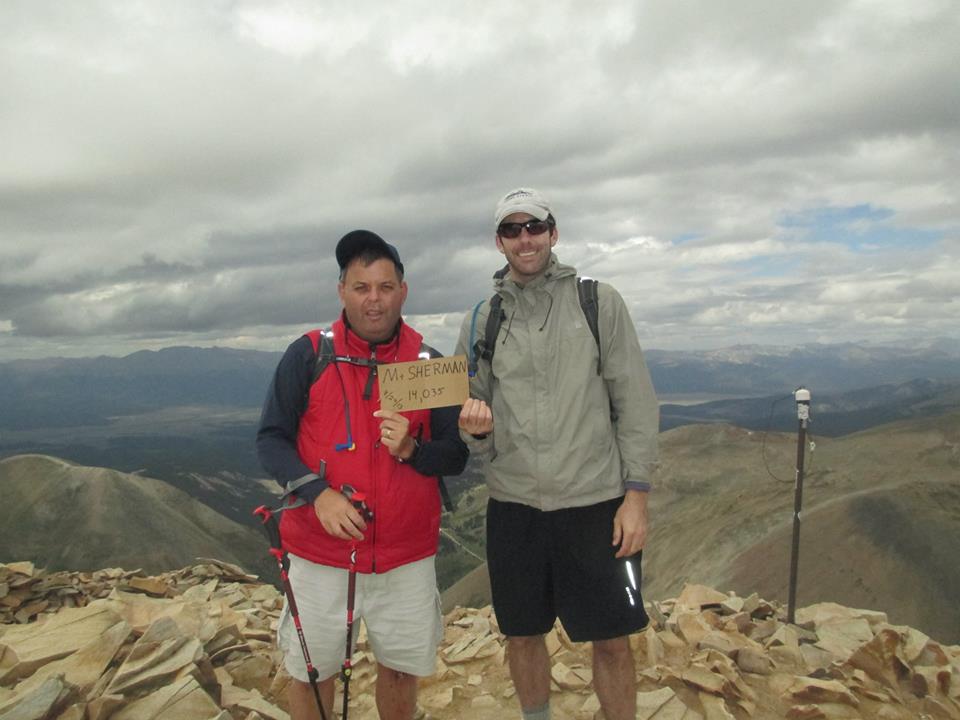OM partner, Seize The World submitted this story for the OM Blog. Thank you, Seize the World for sharing and building awareness.
This month, Seize The World veteran and endurance athlete Brad Rinehart took some time to speak about a recent milestone: completing the Denver Rock ‘n’ Roll Marathon. In order to prepare, Brad worked closely with team coach (and STW Development Director) Charles Koller. Part of that training even involved an epic climb of the 14,036 foot Mt. Sherman in August, together with John Olson and Colorado Climbers for Epilepsy Awareness as well as Outdoor Mindset and Seize The World. Brad lives with his wife Tracy in Aurora, CO. Together, they are an amazing couple: outgoing and kind, but also undaunted by the challenges of epilepsy.
This interview is from a phone conversation with Brad last week about his recent adventures and accomplishments.

Brad Rinehart crossing the finish line of the Denver Rock ‘n’ Roll Marathon. Completing a marathon had been a long-term goal for Brad. He experienced three seizures on the morning of the race. (Photo by Ian McKittrick)
It’s really easy, you do everything: you do a 5k, you a 10k, you kinda do them all, right? I guess as a runner you want to finish off your big long run eventually, you want to complete the cycle. I always said, eventually I want to do a full marathon. And I said ‘this is the perfect opportunity.”
With the Rock ‘n’ Roll Marathon in Denver you mean?
Yes, and I had so much support—I could not have made it through the whole marathon without my coach, Charles, I could not have made it through without his help. And doing it with Seize The World, they really helped me out. This was just the perfect opportunity to do the full marathon. I would never have done the full marathon by myself, you know what I mean? It was basically right in the back yard too.
What were some of the challenges you faced in preparing?
Well, I said to Charles, “Ok, I guess I am going to run the full marathon.” And that (26.1 miles) was just a big number. It was a big number in itself. And I just kept telling myself, “I’m going to do this.”

Brad Rinehart running with Charles Koller on 17th st. in the Rock ‘n’ Roll Marathon. Charles helped Brad with training and preparation for the marathon.
What was your training plan?
Just about every other day I would take my dog and then run a little bit and then walk a little bit. Each day I would try to build up my mileage. You know what it’s like: You have your bad days, you have to push up your mileage. I still kept thinking: “Am I going to make this thing?” There was always that.
Were there any moments when you thought to yourself, “what am I doing here?”
On race day, I had three seizures. (Brad had two seizures between 2a.m. and 5a.m. on race day, and a third at 6:00a.m. after meeting up with the team. The marathon began at 7:30 or so.) Then I just said, “Ok it’s just like a normal day.” I just knew that I wanted to finish, it was just kind of the “game on” kind of attitude though. And I wanted to finish. The other thing with the marathon was doing the hike up Mt. Sherman with John Olson and Colorado Climbers for Epilepsy and also the support of Outdoor Mindset. I don’t think I would have ever done that without them.
What was that climb like?
If you could imagine just about a trillion ball bearings or marbles, and if you tried to walk up. No matter where you walked, there is no way you could try to keep your balance. And here are these rocks that have been here for like trillions of years. (Brad is describing the infamous scree fields on Mt. Sherman’s West Slopes and SW Ridge. At one point, he scraped his knees during the hike before borrowing a set of trekking poles to help with balance on the descent).
I think I left a nice trail of blood on the side of the rock…you know, basically, I can laugh at it now, but you know by the time I came all the way down, you could see the parking lot, there was all these rocks you had to go across, but let me tell you, trying to walk across all these boulders, trying to go from one rock to the other, it’s not easy. It was an epic adventure.

Brad Rinehart and Charles Koller atop 14,036ft. Mt. Sherman. The annual climb is organized by John Olson and Colorado Climbers for Epilepsy Awareness.
Did you think about the Mt. Sherman climb while you were running the marathon?
Climbing that, and knowing that I could do that, absolutely pushed me forward for the marathon. I was telling Charles, I was only hoping to make it in 6 hours, but Charles told me I finished in 5 hours and 56 minutes, I still just couldn’t believe I actually finished the thing in that amount of time.
How did your neurologist react to news of the marathon?
What do you think about the recent news with Neuropace and the FDA?
I was really excited to see that thing getting approved, that is really a big deal, I think it is a really big notch. I was one of the first to start off with this [treatment].
Do you have any advice for people trying to find a safer or easier way through life with epilepsy?
No, but I guess you could say it this way: everybody has their bad days and everybody has their good days. One week I could have a perfect week, and the next day I could have a horrible seizure. You just don’t know. You just don’t know. I don’t think there is an answer.
Right now there is no cure for epilepsy. There isn’t. As much as I would like for there to be…if we did, you and I would both be billionaires, wouldn’t we? That’s just…I don’t…we don’t have the answer. Your friends are your safety valves, I guess.
And I know Tracy says a lot of the time when I have a breakthrough [seizure], I have to sleep. Sometimes my seizures just last about 30 seconds and that’s it. Sometimes I’ll just have confusion, and I’ll sit down and that’s the end of it. Everybody has a different trigger and a different cure for their stress. I run, because that’s what cures my stress.








